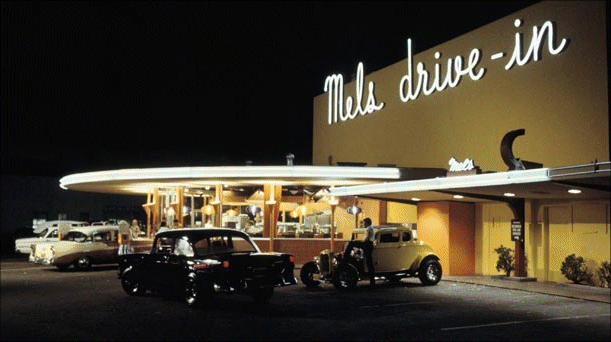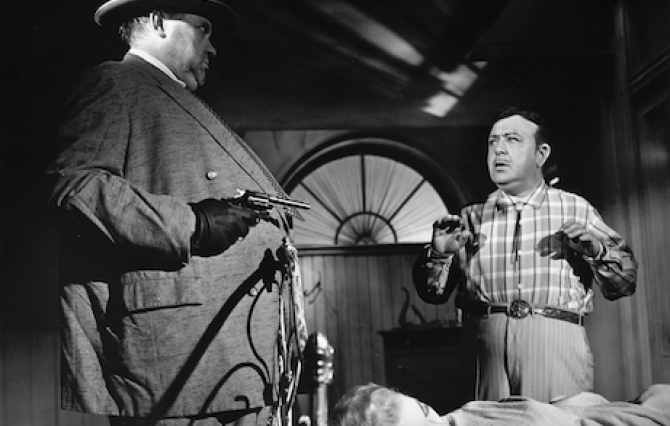Were Movies of the 1950s as White-Washed as Later Films like “Pleasantville” Suggest?
Quick Answer: Through the nostalgic lens of later films like Pleasantville, the 1950s often appears neat, simple and whitewashed. But, looking at the cinematic output from the decade itself, we see that the decade was anything but. Our idealized version of the 1950s comes to us from the censored television of the decade, as well as a comforting image of the decade created by 1970s and 1980s movies and shows that catered to older audiences who wanted to return to more comforting times.
The 1998 film Pleasantville depicts the 1950s as a chaste era in which people were unaware of sex, domestic disharmony didn’t exist, no one defied authority and popularity in high school came from acting like a goody two-shoes. The film pushes these ideas to the extreme — even suggesting that a guy wouldn’t know what to do if a girl drove him to make-out point — and resonated with ‘90s audiences because it satirized familiar assumptions about the ‘50s.
These ideas about the decade that audiences responded to in 1998 were not based on historical reality but on a nostalgic image of the 1950s that was generated in the 1970s and 1980s. Films like Back to the Future (1985), Peggy Sue Got Married (1986), American Graffiti (1973), Stand by Me (1986), Grease (1978), Diner (1982) and especially the TV show Happy Days (1974 - 1984) were created to cater to an older audience that came of age in the Eisenhower era and longed for the simpler times of their youth. Even in the cases of Diner and American Graffiti, which were heavily influenced by their directors’ memories of their own younger years, their popularity reflected older audiences’ desires in the 1970s and 1980s to relive the comforts of their childhood — a kind of counterprogramming to the darker, more complex turns cinema had taken with the new filmmaking class of the 1970s and the effects of the Vietnam War.

American Graffiti (1973)
While nostalgic takes on the 1950s in later films might not have reflected the reality of the decade, they did reflect 1950s television programs like I Love Lucy (1951 - 1957) The George Burns and Gracie Allen Show (1950 - 1958), The Many Lives of Dobie Gillis (1959 - 1963), and The Honeymooners (1955 - 1956). With the exception of The Honeymooners (whose “To the moon, Alice!” catchphrase referred to domestic violence, although the threat was seemingly never acted on), these films depicted politically and domestically harmonious people. Chaste was the key word. Even TV’s most progressive show at the time, I Love Lucy, shied away from suggesting that a husband and wife could sleep in the same bed. Because TV was broadcasting straight to people’s homes, there was an internal pressure within the industry to keep the content clean and safe, and thus an idealized Middle-American version of the 1950s was broadcast back to itself.
But to think that movies were as chaste as TV during this period is a mistake. The turmoil that hit Hollywood with the blacklist and Red Scare had given way to iconoclasts such as Douglas Sirk and Nicholas Ray who thrived on subverting mores. While Leave it to Beaver (1957-1963) reinforced conservative American family values, Douglas Sirk tore the image of the American family apart in films like Imitation of Life (1959) and Written on the Wind (1956). Similarly, Nicholas Ray was a man on the fringes of the Hollywood establishment whose work caught on in the 1950s because there was an audience for his iconoclastic vision. Ironically, his most famous film, Rebel Without a Cause (1955) popularized the leather jacket as a symbol of teenage rebellion, while today we might associate the symbol of a leather jacket with the corniness of nostalgic 50s characters like “The Fonz” on Happy Days.

Touch of Evil (1958)
Moreover, by the 1950s, great filmmakers like Billy Wilder and Howard Hawks were becoming more outwardly risqué with their romantic comedies. A 1940s Billy Wilder/Howard Hawks comedy like Ball of Fire (1941) (directed by Hawks, written by Wilder) is far from stale by today’s standards, but its humor played within the coded limits of the era. Later films like Wilder’s The Seven Year Itch (1955) and Hawks’ Gentlemen Prefer Blondes (1953) were more overtly sexual, commenting openly on love in relation to capitalism and social expectations.
The 1950s also coincided with the decline of the control exerted by studios, as well as the tail ends of the careers of many great Studio Era directors like John Ford. Filmmakers used the opportunity of increased freedom to be more experimental with their work, as Ford did in The Searchers (1956).
Nearly everywhere you look in the catalogue of the 1950s, you will find films that deal with murder, racism, mental illness, the injustice of the prison system, the Red Scare and economic depression: films like Touch of Evil (1958), I Want to Live! (1958), The Three Faces of Eve (1957), Salt of the Earth (1954), The Defiant Ones (1958), and The Night of the Hunter (1955).
Looking through the nostalgic lens of later films, the 1950s often appears neat, simple and whitewashed. But when one looks at the cinematic output from the decade itself, it becomes clear that the decade was anything but.

